What Element of Art Is Most Dominant in Pieta

German fine art has a long and distinguished tradition in the visual arts, from the earliest known work of figurative art to its electric current output of gimmicky fine art.
Deutschland has just been united into a single country since the 19th century, and defining its borders has been a notoriously difficult and painful procedure. For before periods German art often effectively includes that produced in High german-speaking regions including Republic of austria, Alsace and much of Switzerland, as well as largely German-speaking cities or regions to the eastward of the modern High german borders.
Although tending to be neglected relative to Italian and French contributions from the point of view of the English language-speaking world, German art has played a crucial role in the development of Western art, especially Celtic fine art, Carolingian fine art and Ottonian art. From the evolution of Romanesque art, France and Italy began to pb developments for the rest of the Eye Ages, simply the product of an increasingly wealthy Germany remained highly of import.
The German Renaissance developed in rather different directions to the Italian Renaissance, and was initially dominated by the central figure of Albrecht Dürer and the early High german domination of printing. The concluding phase of the Renaissance, Northern Mannerism, was centred effectually the edges of the German lands, in Flanders and the Imperial capital of Prague, but, particularly in architecture, the High german Baroque and Rococo took up these imported styles with enthusiasm. The German origins of Romanticism did not pb to an equally central position in the visual arts, but High german participation in the many broadly Modernist movements following the collapse of Academic art has been increasing important.
Prehistory to Late Artifact [edit]
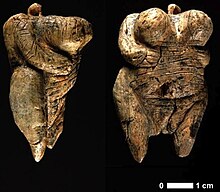
Venus of Hohle Fels, 35,000 to 40,000 BP, the oldest known figurative piece of work of fine art (true height 6 cm (2.4 in)).
The area of modernistic Germany is rich in finds of prehistoric art, including the Venus of Hohle Fels. This appears to be the oldest undisputed example of Upper Paleolithic art and figurative sculpture of the human form in general, from over 35,000 years BP, which was only discovered in 2008;[1] the better-known Venus of Willendorf (24–22,000 BP) comes from a lilliputian way over the Austrian border. The spectacular finds of Statuary Historic period golden hats are centred on Federal republic of germany, as was the "central" form of Urnfield culture, and Hallstatt culture. In the Iron Age the "Celtic" La Tène civilisation centred on Western Germany and Eastern French republic, and Germany has produced many major finds of Celtic art like the elite burials at Reinheim and Hochdorf, and oppida towns like Glauberg, Manching and Heuneburg.[ citation needed ]
Subsequently lengthy wars, the Roman Empire settled its frontiers in Germania with the Limes Germanicus to include much of the south and west of modern Germany. The German language provinces produced art in provincial versions of Roman styles, simply centres there, equally over the Rhine in France, were large-scale producers of fine Ancient Roman pottery, exported all over the Empire.[ commendation needed ] Rheinzabern was i of the largest, which has been well-excavated and has a defended museum.[2]
Non-Romanized areas of the later Roman flow autumn under Migration Flow art, notable for metalwork, peculiarly jewellery (the largest pieces manifestly mainly worn by men).[ commendation needed ]
Middle Ages [edit]

German medieval art really begins with the Frankish Empire of Charlemagne (d. 814), the first state to rule the great bulk of the modern territory of Frg, as well equally France and much of Italy. Carolingian art was restricted to a relatively small number of objects produced for a circle around the court and a number of Imperial abbeys they sponsored, but had a huge influence on later Medieval fine art across Europe. The near common type of object to survive is the illuminated manuscript; wall paintings were evidently mutual but, like the buildings that housed them, take near all vanished. The earlier centres of illumination were located in modern France, but later on Metz in Lorraine and the Abbey of Saint Gall in modernistic Switzerland came to rival them. The Drogo Sacramentary and Folchard Psalter are amidst the manuscripts they produced.[3]
No Carolingian monumental sculpture survives, although perhaps the most important patronage of Charlemagne was his commissioning of a life-size gold figure of Christ on a crucifix for his Palatine Chapel in Aachen; this is only known from literary references and was probably gold foil around a wooden base, probably modelled with a gesso layer, like the later and rather crumpled Aureate Madonna of Essen. Early Christian fine art had not featured monumental sculptures of religious figures as opposed to rulers, as these were strongly associated by the Church Fathers with the cult idols of Aboriginal Roman religion. Byzantine art and modern Eastern Orthodox religious art have maintained the prohibition to the present day, just Western fine art was apparently decisively influenced by the example of Charlemagne to abandon it. Charlemagne'due south circle wished to revive the glories of classical style, which they mostly knew in its Late Antique form, and also to compete with Byzantine fine art, in which they appear to have been helped past refugee artists from the convulsions of the Byzantine iconoclasm. As Charlemagne himself does not appear to accept been very interested in visual art, his political rivalry with the Byzantine Empire, supported past the Papacy, may take contributed to the strong pro-epitome position expressed in the Libri Carolini, which set out the position on images held with lilliputian variation by the Western Church building for the residuum of the Middle Ages, and across.[four]
Under the next Ottonian dynasty, whose cadre territory approximated more closely to modernistic Federal republic of germany, Republic of austria, and German-speaking Switzerland, Ottonian art was mainly a product of the large monasteries, especially Reichenau which was the leading Western artistic heart in the 2d half of the 10th century. The Reichenau style uses simplified and patterned shapes to create strongly expressive images, far from the classical aspirations of Carolingian fine art, and looking forward to the Romanesque. The wooden Gero Cantankerous of 965–970 in Cologne Cathedral is both the oldest and the finest early medieval near life-size crucifix figure; art historians had been reluctant to credit the records giving its date until they were confirmed by dendrochronology in 1976.[5] As in the rest of Europe, metalwork was notwithstanding the nigh prestigious grade of fine art, in works like the jewelled Cross of Lothair, made about 1000, probably in Cologne.[ commendation needed ]
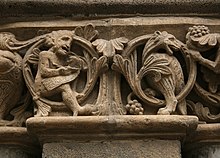
Romanesque art was the beginning artistic movement to cover the whole of Western Europe, though with regional varieties. Frg was a cardinal part of the move, though German language Romanesque architecture made rather less employ of sculpture than that of French republic. With increasing prosperity massive churches were congenital in cities all over Federal republic of germany, no longer merely those patronized by the Purple circumvolve.[6] The French invented the Gothic style, and Germany was slow to prefer it, but once it had done and so Germans made information technology their ain, and connected to employ it long after the rest of Europe had abandoned it. Co-ordinate to Henri Focillon, Gothic immune German art "to define for the commencement time sure aspects of its native genius-a vigorous and emphatic formulation of life and form, in which theatrical ostentation mingled with vehement emotional frankness."[7] The Bamberg Horseman of the 1330s, in Bamberg Cathedral, is the oldest large postal service-antique standing stone equestrian statue; more than medieval princely tomb monuments have survived from Federal republic of germany than French republic or England. Romanesque and Early Gothic churches had wall paintings in local versions of international styles, of which few artists' names are known.[8]

The court of the Holy Roman Emperor, then based in Prague, played an of import function in forming the International Gothic manner in the tardily 14th century.[9] The manner was spread around the wealthy cities of Northern Germany past artists such Conrad von Soest in Westphalia, Meister Bertram in Hamburg, and after Stefan Lochner in Cologne. Hamburg was ane of the cities in the Hanseatic League, when the League was at pinnacle of its prosperity. Bertram was succeeded in the metropolis by artists such equally Master Francke, the Master of the Malchin Altar, Hans Bornemann, Hinrik Funhof and Wilm Dedeke who survived into the Renaissance period. Hanseatic artists painted commissions for Baltic cities in Scandinavia and the modern Baltic states to the east. In the due south, the Main of the Bamberg Chantry is the first significant painter based in Nuremberg, while the Primary of Heiligenkreuz and then Michael Pacher worked in Austria.[ citation needed ]
Like that of Pacher, the workshop of Bernt Notke, a painter from the Hanseatic city of Lübeck, both painted altarpieces or carved them in the increasingly elaborate painted and aureate fashion used as frameworks or alternatives for painted panels. South German wood sculpture was important in developing new subjects that reflected the intensely emotional devotional life encouraged by movements in late medieval Catholicism such as German mysticism. These are frequently known in English every bit andachtsbilder (devotional images) and include the Pietà, Pensive Christ, Human being of Sorrows, Arma Christi, Veil of Veronica, the severed caput of John the Baptist, and the Virgin of Sorrows, many of which would spread beyond Europe and remain popular until the Baroque and, in popular religious imagery, beyond. Indeed "Tardily Gothic Baroque" is a term sometimes used to depict hyper-decorated and emotional 15th-century art, above all in Germany.[10]
Martin Schongauer, who worked in Alsace in the last office of the 15th century, was the culmination of late Gothic German painting, with a sophisticated and harmonious way, but he increasingly spent his time producing engravings, for which national and international channels of distribution had developed, and so that his prints were known in Italy and other countries. His predecessors were the Master of the Playing Cards and Principal Due east. S., both as well from the Upper Rhine region.[11] German conservatism is shown in the belatedly use of gold backgrounds, however used by many artists well into the 15th century.[12]
Renaissance painting and prints [edit]
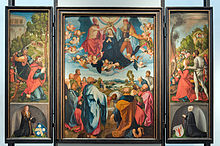
The concept of the Northern Renaissance or German language Renaissance is somewhat confused by the continuation of the utilise of elaborate Gothic ornament until well into the 16th century, even in works that are undoubtedly Renaissance in their handling of the homo figure and other respects. Classical ornament had little historical resonance in much of Germany, but in other respects Federal republic of germany was very quick to follow developments, particularly in adopting printing with movable type, a High german invention that remained almost a German language monopoly for some decades, and was first brought to most of Europe, including France and Italian republic, by Germans.[ citation needed ]
Printmaking past woodcut and engraving (possibly another German invention) was already more developed in Germany and the Low Countries than anywhere else, and the Germans took the lead in developing book illustrations, typically of a relatively low creative standard, but seen all over Europe, with the woodblocks oft being lent to printers of editions in other cities or languages. The greatest artist of the German Renaissance, Albrecht Dürer, began his career as an apprentice to a leading workshop in Nuremberg, that of Michael Wolgemut, who had largely abandoned his painting to exploit the new medium. Dürer worked on the most extravagantly illustrated volume of the period, the Nuremberg Chronicle, published by his godfather Anton Koberger, Europe's largest printer-publisher at the time.[thirteen]
Later on completing his apprenticeship in 1490, Dürer travelled in Germany for four years, and Italy for a few months, before establishing his ain workshop in Nuremberg. He speedily became famous all over Europe for his energetic and balanced woodcuts and engravings, while also painting. Though retaining a distinctively High german way, his piece of work shows strong Italian influence, and is oftentimes taken to represent the beginning of the German Renaissance in visual art, which for the side by side 40 years replaced the Netherlands and France as the area producing the greatest innovation in Northern European fine art. Dürer supported Martin Luther but continued to create Madonnas and other Cosmic imagery, and paint portraits of leaders on both sides of the emerging divide of the Protestant Reformation.[xiii]
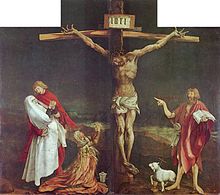
Dürer died in 1528, before it was clear that the carve up of the Reformation had become permanent, but his pupils of the following generation were unable to avoid taking sides. Most leading German artists became Protestants, but this deprived them of painting most religious works, previously the mainstay of artists' revenue. Martin Luther had objected to much Catholic imagery, simply non to imagery itself, and Lucas Cranach the Elder, a close friend of Luther, had painted a number of "Lutheran altarpieces", mostly showing the Terminal Supper, some with portraits of the leading Protestant divines as the Twelve Apostles. This phase of Lutheran fine art was over before 1550, probably under the more fiercely aniconic influence of Calvinism, and religious works for public display virtually ceased to exist produced in Protestant areas. Presumably largely because of this, the evolution of German language art had nearly ceased by nigh 1550, but in the preceding decades German artists had been very fertile in developing alternative subjects to replace the gap in their order books. Cranach, autonomously from portraits, adult a format of thin vertical portraits of provocative nudes, given classical or Biblical titles.[fourteen]
Lying somewhat exterior these developments is Matthias Grünewald, who left very few works, but whose masterpiece, his Isenheim Altarpiece (completed 1515), has been widely regarded as the greatest High german Renaissance painting since it was restored to critical attention in the 19th century. It is an intensely emotional piece of work that continues the German Gothic tradition of unrestrained gesture and expression, using Renaissance compositional principles, but all in that most Gothic of forms, the multi-winged triptych.[15]
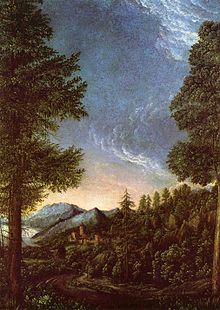
The Danube School is the name of a circle of artists of the offset third of the 16th century in Bavaria and Republic of austria, including Albrecht Altdorfer, Wolf Huber and Augustin Hirschvogel. With Altdorfer in the lead, the school produced the beginning examples of independent mural art in the West (nearly 1,000 years after Cathay), in both paintings and prints.[16] Their religious paintings had an expressionist style somewhat similar to Grünewald's. Dürer's pupils Hans Burgkmair and Hans Baldung Grien worked largely in prints, with Baldung developing the topical subject matter of witches in a number of enigmatic prints.[17]
Hans Holbein the Elder and his brother Sigismund Holbein painted religious works in the late Gothic manner. Hans the Elderberry was a pioneer and leader in the transformation of German language art from the Gothic to the Renaissance way. His son, Hans Holbein the Younger was an important painter of portraits and a few religious works, working mainly in England and Switzerland. Holbein's well known series of small woodcuts on the Dance of Death relate to the works of the Little Masters, a group of printmakers who specialized in very small and highly detailed engravings for conservative collectors, including many erotic subjects.[18]
The outstanding achievements of the first half of the 16th century were followed past several decades with a remarkable absence of noteworthy High german art, other than achieved portraits that never rival the achievement of Holbein or Dürer. The side by side significant German language artists worked in the rather artificial style of Northern Mannerism, which they had to learn in Italy or Flanders. Hans von Aachen and the Netherlandish Bartholomeus Spranger were the leading painters at the Imperial courts in Vienna and Prague, and the productive Netherlandish Sadeler family of engravers spread out across Frg, amidst other counties.[19] This style was continued for another generation by Bartholomeus Strobel, an example of an essentially German artist built-in and working in Silesia, in today's Poland, until he emigrated to escape the Thirty Years State of war and go painter at the Shine court. Adam Elsheimer, the most influential German creative person in the 17th century, spent his whole mature career in Italian republic, where he began by working for another émigré Hans Rottenhammer. Both produced highly finished chiffonier paintings, mostly on copper, with classical themes and landscape backgrounds.[ citation needed ]
Sculpture [edit]
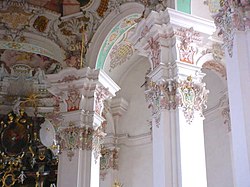
In Catholic parts of South Germany the Gothic tradition of forest carving continued to flourish until the end of the 18th century, adapting to changes in style through the centuries. Veit Stoss (d. 1533), Tilman Riemenschneider (d.1531) and Peter Vischer the Elder (d. 1529) were Dürer'south contemporaries, and their long careers covered the transition between the Gothic and Renaissance periods, although their decoration often remained Gothic even later on their compositions began to reflect Renaissance principles.[20]
Ii and a one-half centuries later, Johann Joseph Christian and Ignaz Günther were leading masters in the late Baroque period, both dying in the late 1770s, barely a decade before the French Revolution. A vital element in the event of German language Baroque interiors was the work of the Wessobrunner School, a subsequently term for the stuccoists of the belatedly 17th and 18th centuries. Some other manifestation of German language sculptural skill was in porcelain; the most famous modeller is Johann Joachim Kaendler of the Meissen manufacturing plant in Dresden, simply the best piece of work of Franz Anton Bustelli for the Nymphenburg Porcelain Factory in Munich is often considered the greatest achievement of 18th-century porcelain.[21]
17th to 19th-century painting [edit]
Baroque, Rococo and Neoclassicism [edit]
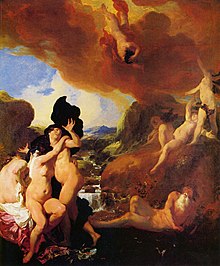

Baroque painting was slow to arrive in Germany, with very petty earlier well-nigh 1650, simply once established seems to have suited German taste well. Baroque and Rococo periods saw German art producing mostly works derivative of developments elsewhere, though numbers of skilled artists in various genres were agile. The period remains little-known outside Germany, and though information technology "never fabricated any claim to exist among the great schools of painting", its neglect by non-German art history remains striking.[22] Many distinguished foreign painters spent periods working in Germany for princes, among them Bernardo Bellotto in Dresden and elsewhere, and Gianbattista Tiepolo, who spent iii years painting the Würzburg Residence with his son. Many German painters worked abroad, including Johann Liss who worked mainly in Venice, Joachim von Sandrart and Ludolf Bakhuisen, the leading marine creative person of the final years of Dutch Gilded Historic period painting. In the tardily 18th century the portraitist Heinrich Füger and his student Johann Peter Krafft, whose all-time known works are three large murals in the Hofburg, had both moved to Vienna as students and stayed there.[23]
Neoclassicism appears rather earlier in Germany than in France, with Anton Raphael Mengs (1728–79), the Danish painter Asmus Jacob Carstens (1754–98), and the sculptor Gottfried Schadow (1764–1850). Mengs was one of the most highly regarded artists of his day, working in Rome, Madrid and elsewhere, and finding an early Neo-Classical style that now seems rather effete, although his portraits are more effective. Carstens' shorter career was turbulent and troubled, leaving a trail of unfinished works, only through pupils and friends such equally Gottlieb Schick, Joseph Anton Koch and Bonaventura Genelli, more influential.[24] Koch was born in the mountains of the Austrian Tyrol and became the leading Continental painter of landscapes, concentrating on mount views, despite spending much of his career in Rome.[ citation needed ]
Daniel Chodowiecki was born in Danzig, and at least partly identified equally Smooth, although he only spoke German and French. His paintings and hundreds of prints, volume illustrations and political cartoons are an invaluable visual record of the everyday life and the increasingly complex mentality of Enlightenment Germany, and its emerging Nationalism.[25] The Swiss-born Anton Graff was a prolific portraitist in Dresden, who painted literary figures as well as the courtroom. The Tischbein family dynasty were solid all-rounders who covered most of the 18th century betwixt them, equally did the Zick family, initially mainly painters of yard Baroque ceilings, who were withal active in the 20th century in the person of the illustrator Alexander Zick.[26] Both the Asam brothers, and Johann Baptist Zimmermann and his brother, were able between them to provide a complete service for commissions for churches and palaces, designing the building and executing the stucco and wall-paintings. The combined outcome of all the elements of these buildings in South Germany, Austria and Bohemia, peculiarly their interiors, stand for some of the most complete and farthermost realizations of the Baroque aspiration to overwhelm the viewer with the "radiant fairy world of the nobleman's dwelling", or the "foretaste of the glories of Paradise" in the case of churches.[27]
The earliest German academy was the Akademie der Künste founded in Berlin in 1696, and through the next two centuries a number of other cities established their ain institutions, in parallel with developments in other European nations. In Germany the uncertain market for art in a land divided into a multitude of small states meant that pregnant German artists have been to the present day more than likely to accept teaching posts in the academies and their successor institutions than their equivalents in England or France have been. In general German academies imposed a item style less rigidly than was for long the case in Paris, London, Moscow or elsewhere.[ citation needed ]
Writing about art [edit]

The Enlightenment period saw High german writers becoming leading theorists and critics of art, led by Johann Joachim Winckelmann, who exalted Aboriginal Greek art and, despite never visiting Greece or actually seeing many Ancient Greek statues, set out an analysis distinguishing between the main periods of Ancient Greek art, and relating them to wider historical movements. Winckelmann'south work marked the entry of art history into the high-philosophical discourse of German culture; he was read avidly past Goethe and Friedrich Schiller, both of whom began to write on the history of art, and his account of the Laocoön Group occasioned a response by Lessing. Goethe had tried to train as an creative person, and his mural sketches bear witness "occasional flashes of emotion in the presence of nature which are quite isolated in the flow".[28] The emergence of fine art every bit a major subject of philosophical speculation was solidified by the appearance of Immanuel Kant's Critique of Judgment in 1790, and was furthered by Hegel's Lectures on Aesthetics. In the post-obit century, German universities were the first to teach fine art history as an academic subject field, get-go the leading position that Federal republic of germany (and Austria) was to occupy in the report of fine art history until the dispersal of scholars abroad in the Nazi period. Johann Gottfried Herder championed what he identified in the Gothic and Dürer as specifically Germanic styles, showtime an argument over the proper models for a German language creative person confronting the so-called "Tyranny of Greece over Deutschland" that would last nearly two centuries.[29]
Romanticism and the Nazarenes [edit]
High german Romanticism saw a revival of innovation and distinctiveness in German art. Outside Germany only Caspar David Friedrich is well-known, simply there were a number of artists with very private styles, notably Philipp Otto Runge, who like Friedrich had trained at the Copenhagen Academy and was forgotten afterwards his death until a revival in the 20th century. Friedrich painted nigh entirely landscapes, with a distinctive Northern experience, and ever a feeling of quasi-religious stillness. Frequently his figures are seen from backside – they like the viewer are lost in contemplation of the landscape.[30] Runge'southward portraits, by and large of his own circle, are naturalistic except for his huge-faced children, just the other works in his brief career increasingly reflected a visionary pantheism.[31] Adrian Ludwig Richter is mainly remembered for his portraits, and Carl Wilhelm Kolbe was purely an etcher (every bit well every bit a philologist), whose later on prints show figures almost swallowed up by gigantic vegetation.[32]

The Nazarene movement, the coinage of a mocking critic, denotes a group of early 19th-century High german Romantic painters who aimed to revive honesty and spirituality in Christian art. The principal motivation of the Nazarenes was a reaction against Neoclassicism and the routine art education of the academy system. They hoped to return to art which embodied spiritual values, and sought inspiration in artists of the late Middle Ages and early Renaissance, rejecting what they saw equally the superficial virtuosity of after fine art. Their programme was non dissimilar to that of the English Pre-Raphaelite Brotherhood in the 1850s, although the cadre group took it as far as wearing special pseudo-medieval article of clothing. In 1810 Johann Friedrich Overbeck, Franz Pforr, Ludwig Vogel and the Swiss Johann Konrad Hottinger moved to Rome, where they occupied the abandoned monastery of San Isidoro. They were joined past Philipp Veit, Peter von Cornelius, Julius Schnorr von Carolsfeld, Friedrich Wilhelm Schadow and a loose group of other German artists. They met upwards with the Austrian romantic landscape creative person Joseph Anton Koch, (1768–1839) who became an unofficial tutor to the group. In 1827 they were joined by Joseph von Führich, and Eberhard Wächter was later associated with the group. Unlike the strong support given to the Pre-Raphaelites by the ascendant art critic of the twenty-four hours, John Ruskin, Goethe was dismissive of the Nazarenes: "This is the first case in the history of fine art when real talents have taken the fancy to form themselves backwards by retreating into their mother'south womb, and thus found a new epoch in art."[33]
Led past the Nazarene Schadow, son of the sculptor, the Düsseldorf school was a group of artists who painted generally landscapes, and who studied at, or were influenced by the Düsseldorf Academy, founded in 1767. The academy's influence grew in the 1830s and 1840s, and it had many American students, several of whom became associated with the Hudson River Schoolhouse.[34]
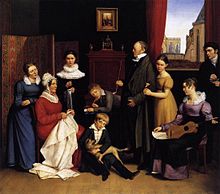
Naturalism and beyond [edit]
Biedermeier refers to a style in literature, music, the visual arts and interior design in the catamenia between the stop of the Napoleonic Wars in 1815 and the revolutions of 1848. Biedermeier fine art appealed to the prosperous middle classes by detailed simply polished realism, often celebrating domestic virtues, and came to dominate over French-leaning aristocratic tastes, likewise every bit the yearnings of Romanticism. Carl Spitzweg was a leading German artist in the way.[35]
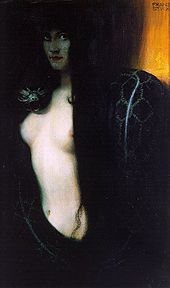
In the second one-half of the 19th century a number of styles developed, paralleling trends in other European counties, though the lack of a dominant uppercase city probably contributed to even more variety of styles than in other countries.[36]
Adolph Menzel enjoyed enormous popularity both amid the High german public and officialdom; at his funeral Wilhelm II, High german Emperor walked behind his coffin. He dramaticised past and gimmicky Prussian military successes both in paintings and brilliant forest engravings illustrating books, yet his domestic subjects are intimate and touching. He followed the development of early Impressionism to create a way that he used for depicting g public occasions, among other subjects like his Studio Wall. Karl von Piloty was a leading academic painter of history subjects in the latter part of the century who taught in Munich; among his more than famous pupils were Hans Makart, Franz von Lenbach, Franz Defregger, Gabriel von Max and Eduard von Grützner. The term "Munich school" is used both of German and of Greek painting, after Greeks like Georgios Jakobides studied under him.[ citation needed ]. Piloty'southward most influential student was Wilhelm Leibl. Being the head of the so chosen Leibl-Circle, an breezy group of artists with a non-academic arroyo to fine art, he had a neat impact on Realism in Frg.[37]
The Berlin Secession was a group founded in 1898 past painters including Max Liebermann, who broadly shared the artistic approach of Manet and the French Impressionists, and Lovis Corinth so however painting in a naturalistic style. The group survived until the 1930s, despite splits, and its regular exhibitions helped launch the next two generations of Berlin artists, without imposing a particular style.[38] Almost the end of the century, the Benedictine Beuron Art School developed a style, mostly for religious murals, in rather muted colours, with a medievalist involvement in pattern that drew from Les Nabis and in some ways looked forward to Art Nouveau or the Jugendstil ("Youth Mode") as it is known in German language.[39] Franz von Stuck and Max Klinger are the leading High german Symbolist painters.[ commendation needed ]
20th century [edit]

Fifty-fifty more than in other countries, High german art in the early 20th century developed through a number of loose groups and movements, many covering other creative media equally well, and ofttimes with a specific political element, equally with the Arbeitsrat für Kunst and November Grouping, both formed in 1918. In 1922 The November Group, the Dresden Secession, Das Junge Rheinland, and several other progressive groups formed a "Cartel of advanced artistic groups in Deutschland" (Kartell fortschrittlicher Künstlergruppen in Deutschland) in an try to proceeds exposure.[40]
Dice Brücke ("The Bridge") was one of 2 groups of High german painters fundamental to expressionism, the other being Der Blaue Reiter group. Die Brücke was a group of German expressionist artists formed in Dresden in 1905 by compages students who wanted to be painters: Fritz Bleyl (1880–1966), Erich Heckel (1883–1970), Ernst Ludwig Kirchner (1880–1938) and Karl Schmidt-Rottluff (1884–1976), with Max Pechstein and others later joining.[41] The notoriously individualistic Emil Nolde (1867–1956) was briefly a member of Die Brücke, only was at odds with the younger members of the grouping. Die Brücke moved to Berlin in 1911, where information technology eventually dissolved in 1913. Perhaps their most important contribution had been the rediscovery of the woodcut every bit a valid medium for original artistic expression.[ commendation needed ]
Der Blaue Reiter ("The Blue Passenger") formed in Munich, Germany in 1911. Wassily Kandinsky, Franz Marc, August Macke, Alexej von Jawlensky, Marianne von Werefkin and others founded the grouping in response to the rejection of Kandinsky's painting Terminal Judgment from an exhibition by Neue Künstlervereinigung—another artists' group of which Kandinsky had been a member. The name Der Blaue Reiter derived from Marc's enthusiasm for horses, and from Kandinsky'southward honey of the colour blue. For Kandinsky, blueish is the color of spirituality—the darker the blue, the more than it awakens human desire for the eternal (see his 1911 book On the Spiritual in Art). Kandinsky had besides titled a painting Der Blaue Reiter (see illustration) in 1903.[42] The intense sculpture and printmaking of Käthe Kollwitz was strongly influenced by Expressionism, which also formed the starting signal for the young artists who went on to join other tendencies within the movements of the early 20th century.[43]
Die Brücke and Der Blaue Reiter were both examples of tendency of early 20th-century German art to be "honest, direct, and spiritually engaged"[44] The difference in how the ii groups attempted this were telling, however. The artists of Der Blaue Reiter were less oriented towards intense expression of emotion and more towards theory- a tendency which would lead Kandinsky to pure abstraction. Still, information technology was the spiritual and symbolic properties of abstract grade that were important. At that place were therefore Utopian tones to Kandinsky's abstractions: "We have before us an age of conscious creation, and this new spirit in painting is going hand in hand with thoughts toward an epoch of greater spirituality."[45] Dice Brücke also had Utopian tendencies, but took the medieval arts and crafts gild as a model of cooperative work that could amend society- "Everyone who with directness and authenticity conveys that which drives him to cosmos belongs to us".[46] The Bauhaus also shared these Utopian leanings, seeking to combine fine and applied arts (Gesamtkunstwerk) with a view towards creating a better club.[ citation needed ]
Weimar period [edit]
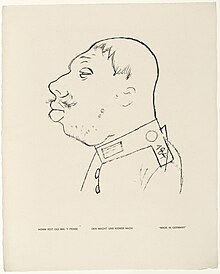
Fabricated in Federal republic of germany (German language: Den macht uns keiner nach), past George Grosz, drawn in pen 1919, photo-lithograph 1920.
A major feature of German art in the early on 20th century until 1933 was a boom in the production of works of art of a grotesque way.[47] [48] Artists using the Satirical-Grotesque genre included George Grosz, Otto Dix and Max Beckmann, at least in their works of the 1920s. Dada in Germany, the leading practitioners of which were Kurt Schwitters and Hannah Höch, was centered in Berlin, where information technology tended to be more politically oriented than Dada groups elsewhere.[49] They made important contributions to the development of collage as a medium for political commentary- Schwitters later adult his Merzbau, a forerunner of installation art.[49] Dix and Grosz were besides associated with the Berlin Dada group. Max Ernst led a Dada group in Cologne, where he too practiced collage, only with a greater involvement in Gothic fantasy than in overt political content—this hastened his transition into surrealism, of which he became the leading High german practitioner.[50] The Swiss-born Paul Klee, Lyonel Feininger and others experimented with cubism.[ citation needed ]
The New Objectivity, or Neue Sachlichkeit (new affair-of-factness), was an art movement which arose in Germany during the 1920s every bit an outgrowth of, and in opposition to, expressionism. It is thus postal service-expressionist and applied to works of visual art also as literature, music, and architecture. It describes the stripped-down, simplified building way of the Bauhaus and the Weissenhof Settlement, the urban planning and public housing projects of Bruno Taut and Ernst May, and the industrialization of the household typified past the Frankfurt kitchen. Grosz and Dix were leading figures, forming the "Verist" side of the movement with Beckmann and Christian Schad, Rudolf Schlichter, Georg Scholz (in his early work), Elfriede Lohse-Wächtler, and Karl Hubbuch. The other tendency is sometimes chosen Magic Realism, and included Anton Räderscheidt, Georg Schrimpf, Alexander Kanoldt, and Carl Grossberg. Unlike some of the other groupings, the Neue Sachlichkeit was never a formal group, and its artists were associated with other groups; the term was invented by a sympathetic curator, and "Magic Realism" by an fine art critic.[51]
Plakatstil, "poster style" in German, was an early style of poster design that began in the early 20th century, using bold, straight fonts with very simple designs, in contrast to Fine art Nouveau posters. Lucian Bernhard was a leading figure.[ commendation needed ]
Fine art in the Third Reich [edit]
The Nazi regime banned modern art, which they condemned as degenerate fine art (from the German language: entartete Kunst). Co-ordinate to Nazi ideology, modernistic art deviated from the prescribed norm of classical beauty. While the 1920s to 1940s are considered the heyday of mod art movements, there were conflicting nationalistic movements that resented abstract art, and Germany was no exception. Avant-garde German artists were at present branded both enemies of the state and a threat to the German nation. Many went into exile, with relatively few returning after World State of war 2. Dix was one who remained, being conscripted into the Volkssturm Home Baby-sit militia; Pechstein kept his head downwards in rural Pomerania. Nolde likewise stayed, creating his "unpainted pictures" in secret after being forbidden to paint. Beckmann, Ernst, Grosz, Feininger and others went to America, Klee to Switzerland, where he died. Kirchner committed suicide.[52]
In July, 1937, the Nazis mounted a polemical exhibition entitled Entartete Kunst (Degenerate art), in Munich; it subsequently travelled to eleven other cities in Germany and Austria. The show was intended as an official condemnation of modern art, and included over 650 paintings, sculptures, prints, and books from the collections of xxx two German museums. Expressionism, which had its origins in Germany, had the largest proportion of paintings represented. Simultaneously, and with much pageantry, the Nazis presented the Grosse deutsche Kunstausstellung (Dandy German art exhibition) at the palatial Haus der deutschen Kunst (Business firm of High german Art). This exhibition displayed the work of officially approved artists such as Arno Breker and Adolf Wissel. At the end of four months Entartete Kunst had attracted over two million visitors, nearly 3 and a half times the number that visited the nearby Grosse deutsche Kunstausstellung.[53]
Post-Earth State of war II art [edit]
![]()

Joseph Beuys, wearing his ubiquitous fedora, delivers a lecture on his theory of social sculpture, 1978
Postal service-war art trends in Germany can broadly be divided into Socialist realism in the DDR (communist East Germany), and in West Germany a variety of largely international movements including Neo-expressionism and Conceptualism.[ citation needed ]
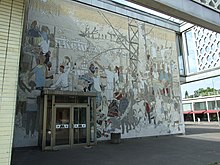
Notable socialist realism include or included Walter Womacka, Willi Sitte, Werner Tübke and Bernhard Heisig.
Especially notable neo-expressionists include or included Georg Baselitz, Anselm Kiefer, Jörg Immendorff, A. R. Penck, Markus Lüpertz, Peter Robert Keil and Rainer Fetting. Other notable artists who work with traditional media or figurative imagery include Martin Kippenberger, Gerhard Richter, Sigmar Polke, and Neo Rauch.[ citation needed ]
Leading German conceptual artists include or included Bernd and Hilla Becher, Hanne Darboven, Hans-Peter Feldmann, Hans Haacke, and Charlotte Posenenske.[54]
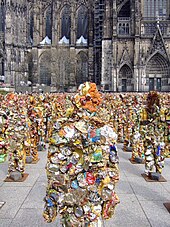
HA Schult, Trash People, shown in Cologne
The Performance artist, sculptor, and theorist Joseph Beuys was perchance the nigh influential German artist of the late 20th century.[55] His main contribution to theory was the expansion of the Gesamtkunstwerk to include the whole of society, as expressed by his famous expression "Everyone is an artist". This expanded concept of art, known equally social sculpture, defines everything that contributes creatively to social club as artistic in nature. The form this took in his oeuvre varied from richly metaphoric, almost shamanistic performances based on his personal mythology (How to Explain Pictures to a Dead Hare, I Similar America and America Likes Me) to more direct and commonsensical expressions, such every bit 7000 Oaks and his activities in the Greenish political party.[ citation needed ]
Famous for their happenings are HA Schult and Wolf Vostell. Wolf Vostell is also known for his early installations with television. His start installations with tv set the Cycle Black Room from 1958 was shown in Wuppertal at the Galerie Parnass in 1963 and his installation 6 Tv set Dé-coll/age was shown at the Smolin Gallery [56] in New York besides in 1963.[57] [58]
The fine art group Gruppe SPUR included: Lothar Fischer (1933–2004), Heimrad Prem (1934–1978), Hans-Peter Zimmer (1936–1992) and Helmut Sturm (1932). The SPUR-artists met first at the Academy of Fine Arts, Munich and, before falling out with them, were associated with the Situationist International. Other groups include the Junge Wilde of the late 1970s to early on 1980s.[ citation needed ]
documenta (sic) is a major exhibition of contemporary art held in Kassel every five years (2007, 2012...), Art Cologne is an annual art fair, again mostly for contemporary fine art, and Transmediale is an annual festival for art and digital culture, held in Berlin.[ citation needed ]
Other contemporary German artists include Jonathan Meese, Daniel Richter, Albert Oehlen, Markus Oehlen, Rosemarie Trockel, Andreas Gursky, Thomas Ruff, Blinky Palermo, Hans-Jürgen Schlieker, Günther Uecker, Aris Kalaizis, Katharina Fritsch, Fritz Schwegler and Thomas Schütte.[ commendation needed ]
Notes [edit]
- ^ Venus figurine sheds calorie-free on origins of fine art by early humans Los Angeles Times, May fourteen, 2009, accessed December eleven, 2009
- ^ Terra Sigillata Museum Rheinzabern (in High german)
- ^ Run across Hinks throughout, Capacity one of Beckwith and 3–4 of Dodwell
- ^ Dodwell, 32 on the Libri Carolini
- ^ Beckwith, Chapter ii
- ^ Beckwith, Chapter iii
- ^ Focillon, 106
- ^ Dodwell, Affiliate 7
- ^ Levey, 24-7, 37 & passim, Snyder, Chapter II
- ^ Snyder, 308
- ^ Snyder, Chapters Four (painters to 1425), 7 (painters to 1500), XIV (printmakers), & Xv (sculpture).
- ^ Focillon, 178–181
- ^ a b Bartrum (2002)
- ^ Snyder, Part 3, Ch. Xix on Cranach, Luther etc.
- ^ Snyder, Ch. XVII
- ^ Woods, 9 – this is the principal discipline of the whole book
- ^ Snyder, Ch. XVII, Bartrum, 1995
- ^ Snyder, Ch. Xx on the Holbeins, Bartrum (1995), 221–237 on Holbein's prints, 99–129 on the Little Masters
- ^ Trevor-Roper, Levey
- ^ Snyder, 298–311
- ^ Fell, 156
- ^ Griffiths & Carey, 24 (quotation), and Scheyer, 9 (from 1960, only the point remains valid)
- ^ Novotny, 62–65
- ^ Novotny, 49–59
- ^ Griffiths & Carey, 50–68, Novotny, sixty–62
- ^ Novotny, 60
- ^ Gombrich, 352–357; quotes from pp. 355 & 357
- ^ Novotny, 78 (quotation); and run across alphabetize for Winckelmann etc.
- ^ The rhetorical phrase was coined, or popularized, by: Butler, Eliza M., "The Tyranny of Greece over Federal republic of germany: a study of the influence exercised past Greek fine art and verse over the dandy German writers of the eighteenth, nineteenth, and twentieth centuries" (Cambridge Univ. Press, London, 1935)
- ^ Novotny, 95–101
- ^ Novotny, 106–112
- ^ Griffiths and Carey, 112–122
- ^ Griffiths & Carey, 24–25 and passim, quotation from p. 24
- ^ John Yard. Howat: American Paradise: The World of the Hudson River School, South. 311
- ^ Doyle, Margaret, in Encyclopedia of the Romantic Era, 1760–1850, Volume 1, ed. Christopher John Murray, p. 89, Taylor & Francis, 2004 ISBN 1-57958-361-Ten, Google books
- ^ Hamilton, 180
- ^ Wilhelm Leibl. The art of seeing, Kunsthaus Zürich, 2019
- ^ Hamilton, 181–184, and see index for later on mentions
- ^ Hamilton, 113
- ^ Crockett, Dennis (1999). German Post-Expressionism : The Art of the Nifty Disorder 1918–1924. University Park, Pa: Pennsylvania State University Press. p. 76. ISBN 0271043164.
- ^ Hamilton, 197–204, and Honour & Fleming, 569–576
- ^ Honour & Fleming, 569–576, and Hamilton, 215–221
- ^ Hamilton, 189–191
- ^ Hunter, Jacobus, and Wheeler (2000) p. 113
- ^ qtd. Hunter et al p. 118
- ^ From the Manifesto of Die Brücke, qtd Hunter et al p. 113
- ^ Esti Sheinberg (2000) Irony, Satire, Parody and the Grotesque in the Music of Dmitrii Shostakovich, pp.248–9, ISBN 978-0-7546-0226-2
- ^ Pamela Kort (2004) Comic Grotesque, Prestel Publishing ISBN 978-3-7913-3195-9
- ^ a b Hunter, Jacobus, and Wheeler (2000) pp. 173–77
- ^ Hamilton, 473–478
- ^ Hamilton, 478–479
- ^ "Ernst Ludwig Kirchner Biography, Art, and Analysis of Works". Retrieved 2015-09-29 .
- ^ Hamilton, 486–487
- ^ Marzona, Daniel. (2005) Conceptual Fine art. Cologne: Taschen. Various pages
- ^ Moma Focus, retrieved 16 December 2009
- ^ Rolf Wedewer. Wolf Vostell. Retrospektive, 1992, ISBN 3-925520-44-ix
- ^ Wolf Vostell, Cycle Blackness Room, 1958, installation with television
- ^ Wolf Vostell, 6 TV Dé-coll/age, 1963, installation with boob tube
References [edit]
Further reading [edit]
- German language masters of the nineteenth century: paintings and drawings from the Federal Republic of Germany . New York: The Metropolitan Museum of Art. 1981. ISBN978-0-87099-263-6.
- Nancy Marmer, "Isms on the Rhine: Westkunst," Fine art in America, Vol. 69, November 1981, pp. 112–123.
Source: https://en.wikipedia.org/wiki/German_art
0 Response to "What Element of Art Is Most Dominant in Pieta"
Postar um comentário